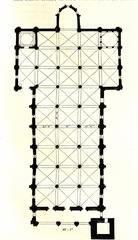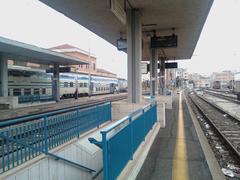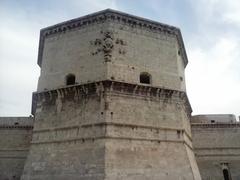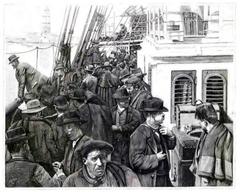
Comprehensive Guide to Visiting Civitavecchia, Metropolitan City of Rome, Italy
Date: 13/08/2024
Captivating Introduction
Welcome to Civitavecchia, a city where the past and present blend seamlessly, creating a rich tapestry that beckons travelers with its storied charm and vibrant modernity. Imagine stepping into a place where ancient Etruscan whispers mingle with the grand echoes of the Roman Empire (Virgin Voyages). Founded as ‘Centumcellae’ by Emperor Trajan in 107 AD, Civitavecchia’s history is as deep and intricate as the creeks and rooms its name might refer to (The Common Traveler). From the medieval resilience against Saracen invasions to the bustling free port of the Renaissance under Pope Innocent XII, this city has always been a beacon of resilience and transformation (Travopo). Today, Civitavecchia stands as a major cruise and ferry port, its docks and streets humming with life, while its historic sites like Forte Michelangelo and the ancient Roman dock connect visitors to a rich past. Let’s embark on a journey through Civitavecchia’s unique blend of history, culture, and modern attractions, offering a captivating narrative and practical tips for an unforgettable visit.
Table of Contents
- Historical Overview of Civitavecchia
- Main Attractions
- Visitor Tips for Civitavecchia, Metropolitan City of Rome, Italy
Historical Overview of Civitavecchia
Etruscan and Roman Origins
Civitavecchia’s roots trace back to a small Etruscan settlement thriving amidst lush hills and mysterious tombs. By 107 AD, Emperor Trajan had given the city its ancient name, ‘Centumcellae.’ Trajan’s harbor, crafted by the genius Apollodorus of Damascus, was revolutionary, outshining the ports of Ostia and Portus. Even today, the Roman dock continues to hum with commercial activity, a living testament to the city’s enduring significance.
Medieval Period and Saracen Invasions
In 828 AD, Saracen invaders stormed the city, forcing its inhabitants to seek refuge in the mountains where they founded ‘Cencelle.’ By 889 AD, they returned to their old home, renaming it ‘Civitas Vetula,’ or ‘old city.’ Pope Leo IV constructed a fortified town in the Allumiere Mountains during this tumultuous period, but the heart of the city always called its people back.
Renaissance and Early Modern Period
In 1696, under Pope Innocent XII, Civitavecchia blossomed into a bustling free port. The French Empire’s occupation in 1806 saw novelist Stendhal serving as consul here. The Rome and Civitavecchia railway, opened on April 16, 1859, connected the city to Rome, transforming it significantly. The colossal Forte Michelangelo, initiated by Pope Julius II and featuring Michelangelo’s own design on its ‘maschio’ tower, stands as a sentinel of history.
19th and 20th Centuries
In 1870, the fortress’s gates swung open to Italian general Nino Bixio, marking the end of papal control and integrating the port into the Kingdom of Italy. Although World War II brought destruction through Allied bombing raids, the spirit of Civitavecchia remained unbroken.
Post-War Reconstruction and Modern Era
Post-World War II, Civitavecchia rose from the ashes, expanding and evolving into a major cruise and ferry port. Today, it connects central Italy to Sardinia, Sicily, Tunis, and Barcelona. Amidst its modernity, the city houses two thermal power stations, although the coal conversion of one has sparked environmental debates.
Key Historical Sites
Forte Michelangelo
The crown jewel of Civitavecchia’s historical sites, Forte Michelangelo stands tall with its six-meter thick walls. Originally built to fend off pirates, its robust structure and storied past make it a must-visit.
Roman Dock
Trajan’s ancient harbor still serves the city, its curved breakwater and northern arches whispering tales of bygone eras.
Torre di Lazzaretto
The lone survivor among the four Roman round towers, Torre di Lazzaretto stands as a beacon of history, with remnants of ancient warehouses speaking of a vibrant past.
In summary, Civitavecchia’s historical narrative is a vibrant tapestry woven with threads of resilience, transformation, and maritime prowess. From ancient Etruscan tombs to bustling modern harbors, Civitavecchia invites you to explore its rich past and dynamic present.
Main Attractions in Civitavecchia, Metropolitan City of Rome, Italy
Forte Michelangelo
This formidable structure, commissioned by Pope Julius II in the early 16th century, was crafted to fend off pirate attacks. Michelangelo Buonarroti himself designed the upper part of the main tower. Wander through the fortress and be enveloped by whispers of Renaissance military architecture. For more, click here.
Terme Taurine
Imagine soaking in ancient thermal baths just like a Roman citizen from the 2nd century AD. At Terme Taurine, explore the well-preserved ruins of caldarium (hot bath), tepidarium (warm bath), and frigidarium (cold bath). Guided tours will immerse you in Roman bathing culture with a dash of engineering marvels.
Civitavecchia Port
Operational since Emperor Trajan’s time in the 2nd century AD, this bustling port is alive with history and modern charm. Stroll along the waterfront, savor fresh seafood, or embark on a boat tour. Local tip: Grab a gelato and watch the ships sail in – it’s pure magic!
Cathedral of San Francesco d’Assisi
Built in the 17th century and dedicated to St. Francis of Assisi, this Baroque beauty is adorned with intricate frescoes and stunning altars. Services are held regularly, and tourists are always welcome.
Aquafelix Water Park
Dive into a world of fun at Aquafelix Water Park! This splash-tastic park boasts a variety of water slides, wave pools, and lazy rivers. It’s one of Lazio’s largest water parks and promises a day of excitement for all ages.
The National Archaeological Museum of Civitavecchia
Housed in an 18th-century former papal granary, the museum’s collection spans Etruscan, Roman, and medieval artifacts, offering a fascinating glimpse into the region’s history. Highlights include ancient pottery, sculptures, and inscriptions.
Piazza Leandra
Legend has it that Piazza Leandra is named after the city’s founder, Leandro. This charming square, one of Civitavecchia’s oldest, is surrounded by historic buildings and hosts the quaint Church of the Star. It’s a local favorite and often buzzes with cultural events and markets.
The Ficoncella Thermal Baths
These natural hot springs, just a few kilometers from the city center, have been a wellness retreat since Roman times. The therapeutic waters are said to work wonders, and the scenic views of the countryside add to the serenity.
The Marina di Civitavecchia
Set sail from the Marina di Civitavecchia, a modern haven for boating enthusiasts. With over 200 berths, a yacht club, and a variety of dining and shopping options, it’s the perfect launchpad for exploring the Tyrrhenian coast.
The Civitavecchia Market
Located in the city center, the market offers fresh produce, seafood, meats, and local specialties. It’s the perfect place to sample traditional Italian foods and pick up unique souvenirs. Pro tip: Try the local cheese and olives – they’re divine!
For more detailed information on these attractions and planning your visit, check out the Virgin Voyages guide to Civitavecchia.
Visitor Tips for Civitavecchia, Metropolitan City of Rome, Italy
Getting There
By Train: Trains from Roma Termini and Roma San Pietro stations whisk you to Civitavecchia in about an hour. For schedules and tickets, check out the Trenitalia website.
By Car: Renting a car in Rome is a breeze. The scenic drive to Civitavecchia takes roughly an hour.
By Cruise Ship: Many adventurers arrive via cruise ships, docking at one of the busiest ports in the Mediterranean. Check with your cruise line for disembarkation details.
Accommodation
Luxury: Indulge in the opulence of La Casa Sul Mare, where private balconies offer breathtaking sea views. More details on their official website.
Mid-Range: Hotel Porto Di Roma offers a cozy, updated setting praised for its friendly staff and amenities. Visit their website for more info.
Local Transportation
Walking: Civitavecchia’s charm is best experienced on foot. Shade from tree-lined streets makes for a delightful stroll between attractions.
Public Transport: Hop on a local bus. Tickets are available at newsstands or directly from the driver. For routes and schedules, check the local transport website.
Taxis: Grab a taxi at the train station or port. Ensure the meter is running or set a fare beforehand.
Attractions
Civitavecchia Port: A bustling port with a 2000-year history, where ancient artifacts meet modern cruise liners. More info here.
Michelangelo Fortress: Built to fend off pirates, this 16th-century fortress offers panoramic views of the town and sea. Discover its storied history here.
Terme Taurine: Uncover the ruins of ancient Roman thermal baths. Details here.
National Archaeological Museum: Home to a treasure trove of Etruscan and Roman artifacts. More info here.
Dining and Shopping
Mercato delle Vettovaglie: With around 230 stands, this market is a feast for the senses. Open from 7:00 a.m. to 2:00 p.m. (closed Sundays). More details here.
Local Cuisine: From seafood pasta to gelato, Civitavecchia’s cuisine is a culinary delight. Discover the best eateries in this guide.
Activities
Beachfront and Promenade: From Michelangelo Fortress to Pirgo, the promenade is alive with restaurants, bars, and sunbathers. More info here.
Statue of Unconditional Surrender: Inspired by the iconic Times Square kiss, this 25-feet tall statue is a selfie magnet. Learn more here.
Cooking Classes: Learn to cook Italian dishes with local chefs. More details here.
Walking Tours: Explore Civitavecchia’s nooks and crannies on foot. More info here.
Teatro Traiano: Catch a show at Italy’s oldest theater. More details here.
Nearby Destinations
Rome: Just an hour away, Rome’s wonders await. Visit the Colosseum, Vatican City, and more. For more info, visit this guide.
Santa Marinella: A coastal gem with sandy beaches and a charming promenade. More details here.
Tarquinia: Known for its Etruscan necropolis and medieval charm. Learn more here.
Bracciano: Nestled by Lake Bracciano, this town offers water sports and a medieval castle. More info here.
Viterbo: Explore this medieval city’s historic center and natural hot springs. More details here.
Tuscania: A village rich in Roman and medieval history. Learn more here.
Capalbio: A hilltop village with panoramic views of the countryside and sea. More info here.
Practical Tips
Currency: The Euro (€) is the currency. Carry some cash, as not all places accept cards.
Language: Italian is the lingua franca, but many locals speak English. A few Italian phrases can go a long way.
Safety: Civitavecchia is safe, but stay vigilant as you would anywhere. Keep an eye on your belongings.
Weather: Visit in spring (April to June) or fall (September to October) for the best weather. Summers can be scorching, and winters are mild.
Local Etiquette: Politeness is key. Greet with a smile and a simple “Ciao” or “Buongiorno.”
Call to Action
Civitavecchia, the gateway to Rome, is more than just a stopover; it’s a destination brimming with history, culture, and endless discoveries. From its ancient Etruscan roots and Roman engineering marvels like Trajan’s harbor, to the resilience shown during medieval Saracen invasions and its Renaissance blossoming under Pope Innocent XII, Civitavecchia narrates a story of transformation and endurance (Virgin Voyages). Today, as a bustling modern port, it offers a unique blend of historical sites like Forte Michelangelo and modern attractions such as Aquafelix Water Park and the lively Civitavecchia Market (Travopo). Whether you’re wandering through its historic forts, soaking in thermal baths, or savoring local delicacies, Civitavecchia promises a rich and immersive experience. Don’t miss the chance to explore this captivating city with Audiala, your perfect travel companion, offering expert insights and hidden gems. Download Audiala to unlock the secrets and stories of Civitavecchia, making your journey truly unforgettable.
References
- Virgin Voyages, 2024, Virgin Voyages
- The Common Traveler, 2024, The Common Traveler
- Travopo, 2024, Travopo















